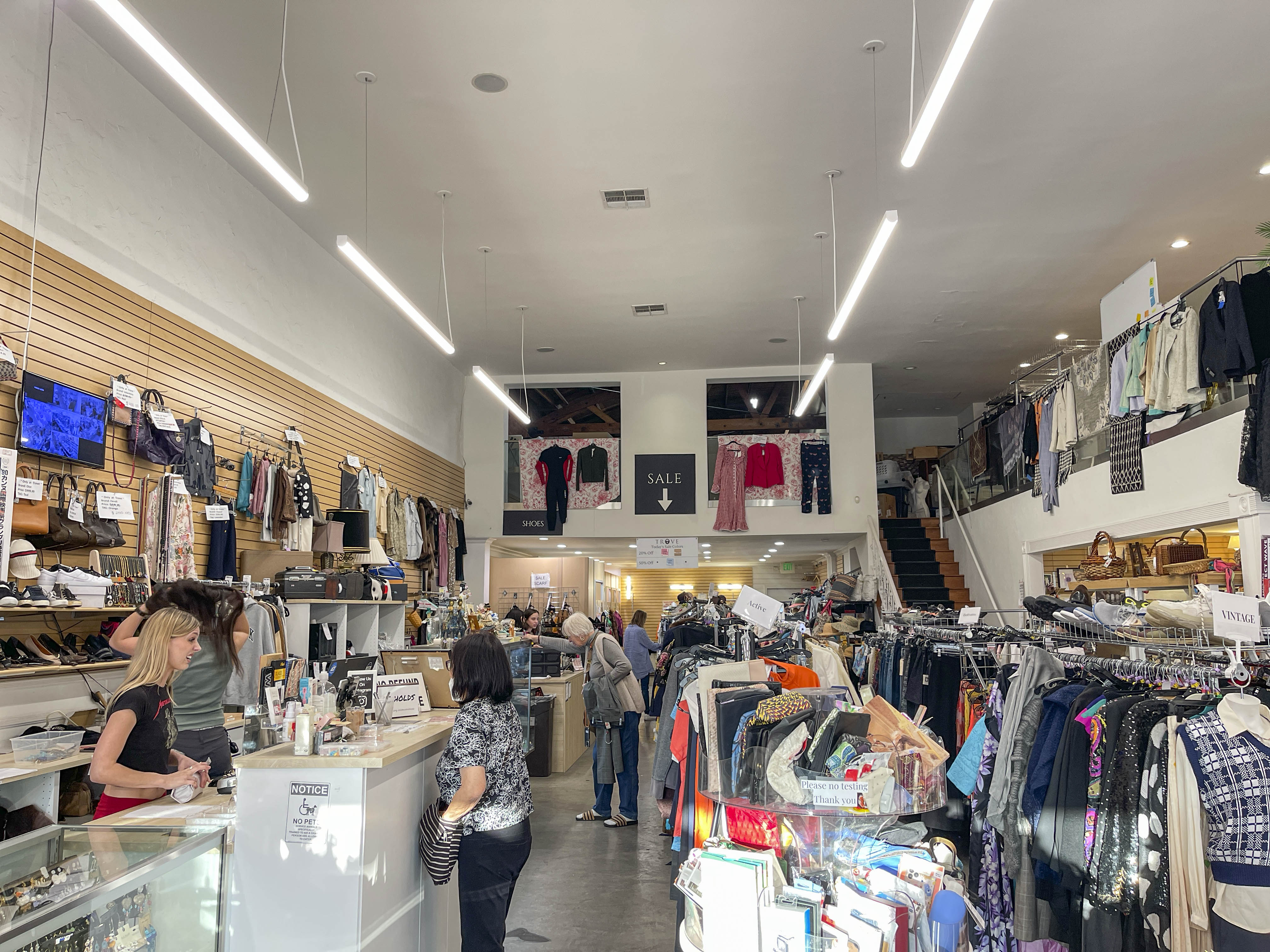The rise of thrifting and the dilemma of sustainability, ethics and affordability

Customers shop for items at Trove, a second-hand store in Los Angeles. (Brandon Morquecho/Assistant Photo editor)
By Lex Wang
Nov. 2, 2023 11:03 p.m.
The consumer industry has been facing a dilemma as the trend of second-hand clothes shopping grows in popularity.
One of the latest movements in fashion has turned customers toward thrifting – or shopping for used goods at second-hand stores – and away from fast fashion clothing that is mass-produced at a rapid rate to keep up with trends. Younger generations seem to have realized the benefits of thrift shopping, whether that is for its relatively low cost or the sustainability of its practices. Seventy-five percent of all United States consumers and 83% of U.S. consumers belonging to Generation Z have either shopped or are willing to shop for second-hand apparel, according to online consignment and thrift platform thredUP’s 2023 annual resale report.
“In the combination of those two – being affordable but also good environmentally for the planet – I think that the trend of thrifting and the trend of getting clothes secondhand has skyrocketed,” said Zoe Yee, a second-year microbiology, immunology and molecular genetics student.
However, there is a debate surrounding ethics and social responsibility when it comes to thrifting. While the popularity of second-hand shopping has empowered sustainability, it can simultaneously drive up prices to unaffordable ranges, which can be concerning for lower-income individuals who often look for second-hand shopping out of necessity rather than a trend.
Yee – who is also the marketing chair of Unravel at UCLA, a fashion, sustainability and social justice club – said many see an issue with the way manufacturers produce massive amounts of clothing in an environmentally questionable manner to keep up with the rate at which fashion fads come in and out of style. These procedures may use high levels of water and energy, according to Goodwill, with one cotton shirt requiring the use of around 700 gallons of water and one pair of jeans requiring 2,000 gallons.
As such, extending the use of clothing, which encourages consumers to purchase new clothing less frequently, can reduce the extent of unnecessary waste, said Felipe Caro, a professor of decisions, operations and technology management at the UCLA Anderson School of Management.
Yee said the environmental benefits of thrifting could have raised demand for second-hand clothing. Presuming demand for second-hand clothing is what has allowed thrift stores to hike prices up – as opposed to supply chain problems or inflation, which can also affect pricing – prices may not necessarily remain at those high levels, Caro said.
Instead, if increasing demand is the cause of the price increase, more players including big clothing chains may enter the industry, creating market competition that would put downward pressure on prices, Caro said, until eventually market prices reach an equilibrium. Some stores already have in the past.
“They (H&M) indeed did explore second-hand clothes at one point, and it failed. They had to close it because it wasn’t profitable for them,” Caro said. “The demand isn’t there yet. … These things need a certain scale for big players to get involved – maybe this is a turning point, and that could be a good thing.”
Danielle Darnault, owner of Los Angeles thrift shop Trove, said the sheer quantity of second-hand clothing sold at thrift stores can allow for both sustainability-focused and affordability-focused shoppers to exist in the market without one consumer group taking away opportunities from the other.
Darnault, who is also a UCLA Anderson School of Management alumnus, said despite common misconceptions, thrift stores can vary significantly in how expensive the items are – ranging from boutiques that sell at rates similar to a Neiman Marcus store to those that more closely mimic the prices of Goodwill.
Trove puts out approximately 200 to 300 items each day, Darnault said, and it mostly sells these goods at the standard market value. As a non-donation-based shop that works with consignors, Trove looks at the trends of listed prices over time and frequently underprices certain pieces when they stay on racks longer than they are usually scheduled for, she added.
On the other hand, Darnault said stores with price points similar to Goodwill see increased competition, which creates more competition among basic necessity items for lower-income groups.
“I don’t think that it’s consignment stores or sites like thredUP or The RealReal that are driving those prices up,” Darnault said. “The competition for the goods that would go to those bins (at donation sites), those hyper-discounted locations, is really steep.”
Caro said the government should take more action to create an economy that favors the environment more, especially when consumers are unable to afford the increasing price of clothes.
“It’s something that governments should do,” Caro said. “You don’t want massive protests of people saying, ‘Now we can’t even afford clothes,’ and that becomes a roadblock for all these changes that we need.”
Overall, consumers should be mindful of thrift store gentrification, Yee said. Those with the financial privilege to buy more clothing shouldn’t do so just because they can, she added, but should instead consider the use they will get out of the items in their wardrobe. However, Yee said she will continue to believe in the value of second-hand shopping, whatever the reason.
“There are enough pieces of clothing to clothe the next six generations, and I think that speaks volumes of how much we are creating and consuming,” Yee said. “Buying second-hand, I will always advocate for, no matter your background, because it’s a more sustainable behavior that can ultimately change how we create and consume clothes in the future. … It’s definitely a behavior that allows us all to live here for longer.”

